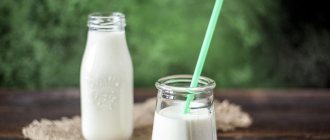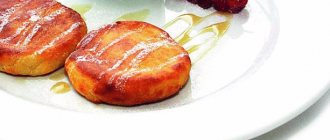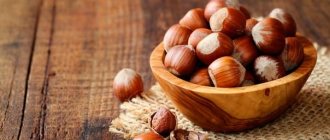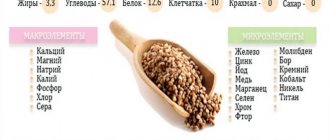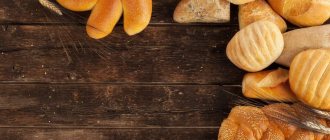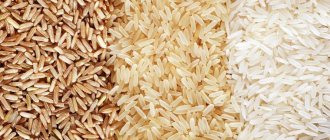I must admit, when I started eating sushi, I acted rather recklessly. In this article I will tell you whether you can eat rolls on a diet. We’ll also talk about the calorie content of rolls and how to eat them correctly so as not to gain weight.
I ate as much as I could and didn't care at all what kind of rolls I ordered; if the description sounded appetizing, then they ended up on my plate.
And this continued until I learned that the benefits and harms of sushi go hand in hand and it is not nearly as healthy a dinner as I thought. Well, at least in the form in which I ordered them.
After paying attention to how many calories are in sushi and the number of calories I received, and listening to the stories of my clients, I came to the conclusion that we tend to overdo it when it comes to sushi.
What are the advantages of Japanese cuisine
- The Japanese philosophy involves maximum trust in nature and immersion in it. Therefore, sushi is usually created based on natural products.
- A harmonious combination of ingredients is an important aspect of the exoticism and sophistication of a dish.
- Seasonings allow you to experience the unusual taste and enjoy the peculiarities of Japanese dishes.
- The original design attracts attention, Japanese food looks very aesthetically pleasing and arouses interest and a desire to try amazing dishes.
The energy value of sushi is so low that you can spend a fasting day on this dish.
Useful properties of the dish
Nutritionists have proven that eating sushi and rolls can really help you lose weight. These are low calorie foods. They give you the opportunity to satisfy your hunger and not gain excess weight. A fasting day can be arranged with these products. To be sure of the quality and composition, it is better to cook it yourself.
Sushi and rolls contain the following beneficial substances:
- Minerals are natural formations consisting of several elements. Affects the health of bones and teeth, the nervous system, blood pressure, cartilage and tissue. These are: calcium, phosphorus, magnesium, potassium, sodium.
- Vitamins are organic compounds necessary for normal development. Sushi and rolls can give a person vitamins B, C and D.
- Amino acids - a large number of them are part of proteins, which can be found in large quantities in fish meat. Very good for vision and bones.
- Microelements - the body constantly needs them. Responsible for the bone marrow and central nervous system. These include: iron, manganese, copper, zinc, selenium.
The main ingredient of rice is a complex carbohydrate. Contains fiber, gives the body energy and improves digestion. Fish and seafood are sources of iodine and protein. The algae used in making rolls is rich in iodine, a mineral for bones.
Improves brain activity. Ginger is served with the main dish. Contains useful microelements. Wasabi – green leaves. They have immunostimulating properties. Soy sauce is rich in fiber and good for digestion.
What products are Japanese dishes made from?
The main ingredient of rolls is rice. Properly prepared, it allows the body to quickly get enough. It contains carbohydrates and fiber - microelements vital for every person.
Fresh, smoked and salted fish, which is also one of the components of a complete Japanese dish, gives sushi a special taste. The freshness of the entire dish depends on the quality of the fish. Professional chefs - specialists in making sushi - know how to combine ingredients in such a way as to achieve the highest taste harmony. Rolls with salmon, tuna and eel are quite popular in Japanese restaurants; they are very nutritious, but low in calories.
Seafood, which is also indispensable during the cooking process, must be fresh and added to the rice in a certain quantity.
Vegetables, seaweed and seasonings play a special role in making sushi. Some of these ingredients add piquancy to the dish, while others are added to enhance or subdue the unusual flavor of the fish or seafood. The most popular vegetarian dish is rolls with avocado and cucumber.
What determines the calorie content of rolls and sushi?
Rolls and sushi are a dietary treat. Per 100 grams there are from 60 to 160 kilocalories. The main reason is the ingredients in the products.
The presence of sauce and fish makes them fatty and high in calories. The advantage is a large number of nutrients and vitamins that will give the body energy during the diet. Knowing the exact composition of a dish, you can independently calculate its calorie content.
Eg:
- tuna sushi weighs approximately 35 kcal;
- salmon - a little more - about 40 kcal;
- smoked eel – 50 kcal.
Dietary sushi includes scallop and perch, octopus and shrimp.
When ordering food in a restaurant, you can safely focus on the following types: “Salmon”, “Avocado”, “Tuna”.
High-calorie ones include: “Philadelphia” and “Dragon Maki”. They range from 40 to 60 points on the calorie system.
The kings of Japanese cuisine contain on average up to 60 kcal. There are recipes that contain no more than 15 kcal per piece.
This option is suitable for those who like to eat and lose weight at the same time. The sushi weight loss diet is a useful procedure, thanks to the large amount of vitamins A, B, C and many others. This type of Japanese cuisine is based on fish. And these are bones, hair, skin, immunity and vision.
What is the benefit
- First of all, it is worth noting that this is a low-calorie food, which may well serve as the basis for a diet.
- The calorie content of Japanese cuisine varies, however, it does not exceed the calorie content of flour products and desserts. That is why restaurants with a similar assortment are more often visited by lovers of healthy food than coffee shops and eateries that offer fast food.
- Rice, seafood and vegetables contain large amounts of microelements that the human body lacks. By eating freshly prepared sushi, you can compensate for the deficiency of fiber, carbohydrates, phosphorus, vitamins and other substances.
Rolls are great for split meals. The volume of one serving is quite small, but they are satisfying and allow you to quickly satisfy your hunger.
Recommendations
Despite the high calorie content of many traditional Japanese dishes, you can still avoid weight gain when eating them if you know some of the nuances.
The most high-calorie and fatty ones are baked, hot and sweet rolls. When losing weight, you definitely shouldn’t look at them.
The lowest calorie is sushi. The portions are light and will help you avoid overeating.
Don't get carried away with wasabi and soy sauce - they are quite high in calories. Also make sure that the composition includes as little other sauces and soft cheese as possible. Mayonnaise, fried bacon and smoked cinnamon are generally best avoided.
It is not recommended to drink sweet carbonated drinks like Cola and Pepsi. They are high in calories. Alcohol is also not a good option. It contributes to loss of control over your own appetite. There is always a risk of overeating.
It is recommended to drink a cup of warm green tea 15-20 minutes after eating. It will help digest heavy foods and prevent carbohydrates and fats from being stored in reserve.
Sushi diet
Going on a diet and at the same time eating well without consuming extra calories is a great option. Since the roll is a very filling product, and the portions are small in volume, you can distribute meals throughout the day so that the body receives enough nutrition and at the same time consumes a minimum of calories. For example, Philadelphia allows you to get enough satiety with a low calorie content of the product. Vegetarian rolls with vegetables, seaweed and mushrooms are also perfect for your diet.
What is the sushi diet? First of all, this is fractional nutrition. Taking into account calories, you should create a menu for the day so that each meal includes sushi or rolls. In total, the entire daily diet should not exceed 1000 kilocalories.
Compound
Sushi is served in many restaurants, cafes, bars, and this food is often delivered to your home. But still, catering establishments must provide customers with the composition of their dishes, nutritional ingredients, and also indicate calorie content. This information must be indicated in printed form on paper, and it must also be online on the official website.
However, not every establishment adheres to this requirement; often the staff cannot even say exactly what the composition of the dish is or what components it contains. But as for calorie content, this will seem like a difficult task for waiters, and almost always they give inaccurate information or completely refuse to answer the question.
It is worth noting! If you are on a diet and watching your figure, then when ordering rolls in a restaurant, carefully study the composition. By eye you can determine whether this dish is high or low calorie.
Low-calorie dishes usually include the following components:
- apples;
- Chuka seaweed;
- Masago caviar: it can be black or red;
- flying fish caviar – red and green;
- meat of squid, shrimp, crab, imitation snow crab, mussels, octopus, scallops, uni;
- Chinese cabbage, iceberg lettuce;
- fresh cucumbers, tomatoes, bell peppers and jalapenos, daikon;
- sesame seeds;
- greens, dill sprigs;
- pickled ginger, asparagus;
- mamenori (soy paper), nori (pressed paper-like sheets of red seaweed);
- shiitake (mushrooms).
Video
But among the high-calorie components the following components can be distinguished:
- avocado;
- bacon;
- smoked chicken meat;
- various types of sea fish;
- spicy sauces, mayonnaise;
- cream cheese, parmesan, mozzarella;
- tomago (Japanese omelette).
Contraindications for use
- Don't get carried away with Japanese cuisine. It is quite unique, so one day a week is enough when you include one or two rolls in your diet, such as Philadelphia, California, Alaska or sushi, the basis of which is seaweed and vegetables, for example, a roll with cucumber.
- You should be very careful with raw fish. If you decide to prepare the dish yourself at home, make sure that all ingredients are fresh.
- Sushi has a very short shelf life, so when ordering it at a restaurant, check how long ago the dish was prepared. When making them at home, it is better not to put them in the refrigerator, but to eat them freshly prepared.
Calorie content of California rolls
This sushi has some variations; the outside is sprinkled with caviar or sesame seeds.
On average, the weight of a standard portion is 175 g. consists of 6 pieces, and the calorie content reaches about 200-225 kcal. To determine their calorie content, you need to understand the type of filling:
Rolls with salmon
The rolls are small in size, since the filling is mainly fish, so the calorie content is low and is about 120 kcal. per 100 gr. or with an increased portion of about 220 kcal. at 180 gr.
Rolls with eel
Calorie content fluctuates around 100-150 kcal. depending on the type and quantity of eel (smoked, raw or fried). A standard serving contains about 170-190 g.
Rolls with cucumber
If you're a vegetable lover and struggle with excess calories every day, then this California variety will be to your liking. In a serving weighing 180 g. will be only 180 kcal, which is a good food for weight loss.
Calorie table of the most popular rolls
| Name | Number of kcal. (in 100 g) |
| California | 176 |
| Philadelphia | 142 |
| Alaska | 90 |
| Unagi maki | 173 |
| Tempura | 165 |
| Kyoto | 155 |
| The Dragon | 189 |
| Philo | 90 |
| Tory Koonsay | 110 |
| Caesar | 113 |
| Vegetables | 70 |
Philadelphia and California rolls are the most popular in Japanese restaurant chains. Firstly, a set of 6-8 pieces is an excellent meal replacement. Secondly, these are the two most delicious and beloved types of sushi. Philadelphia contains rice, salmon, cucumber, avocado, Philadelphia cream cheese, and seaweed. The calorie content of such rolls is inferior to any spring roll or hamburger.
California roll is made from rice, tobiko flying fish roe, crab meat, seaweed and cream cheese. Cucumber and avocado are added. As you can see, these two options are similar in composition, but their taste is completely different.
The calorie content of Philadelphia and California rolls allows you to enjoy the taste of an exotic dish without gaining weight.
Calorie content of Philadelphia rolls
In fact, this type of rolls was invented in Europe, most likely they have gained such popularity and include the following:
- rice;
- nori;
- Philadelphia cheese";
- salmon or salmon;
- avocado;
- soy or rice sauce
Calorie content ranges from 100-150 kcal. per 100 gr. If we compare 1 roll, then its calorie content is about 40-50 kcal.
The final calorie content depends on the filling of the roll and its size. One serving of roll is about 200 grams, so the caloric content of a serving will be 240-400 kcal.
Recipe for Sushi with salmon (30 g = 1 piece = 17 g). Calorie, chemical composition and nutritional value.
Nutritional value and chemical composition of “Sushi with salmon (30 g = 1 piece = 17 g).”
The table shows the nutritional content (calories, proteins, fats, carbohydrates, vitamins and minerals) per 100 grams of edible portion.
| Nutrient | Quantity | Norm** | % of the norm in 100 g | % of the norm in 100 kcal | 100% normal |
| Calorie content | 230 kcal | 1684 kcal | 13.7% | 6% | 732 g |
| Squirrels | 15.2 g | 76 g | 20% | 8.7% | 500 g |
| Fats | 6 g | 56 g | 10.7% | 4.7% | 933 g |
| Carbohydrates | 28.7 g | 219 g | 13.1% | 5.7% | 763 g |
| Alimentary fiber | 4.5 g | 20 g | 22.5% | 9.8% | 444 g |
| Water | 47 g | 2273 g | 2.1% | 0.9% | 4836 g |
| Ash | 2.564 g | ~ | |||
| Vitamins | |||||
| Vitamin A, RE | 23.5 mcg | 900 mcg | 2.6% | 1.1% | 3830 g |
| Retinol | 0.024 mg | ~ | |||
| Vitamin B1, thiamine | 0.247 mg | 1.5 mg | 16.5% | 7.2% | 607 g |
| Vitamin B2, riboflavin | 0.176 mg | 1.8 mg | 9.8% | 4.3% | 1023 g |
| Vitamin B4, choline | 40 mg | 500 mg | 8% | 3.5% | 1250 g |
| Vitamin B5, pantothenic | 0.282 mg | 5 mg | 5.6% | 2.4% | 1773 |
| Vitamin B6, pyridoxine | 0.254 mg | 2 mg | 12.7% | 5.5% | 787 g |
| Vitamin B9, folates | 16.471 mcg | 400 mcg | 4.1% | 1.8% | 2429 g |
| Vitamin C, ascorbic acid | 0.59 mg | 90 mg | 0.7% | 0.3% | 15254 g |
| Vitamin E, alpha tocopherol, TE | 1.435 mg | 15 mg | 9.6% | 4.2% | 1045 g |
| Vitamin H, biotin | 5.647 mcg | 50 mcg | 11.3% | 4.9% | 885 g |
| Vitamin RR, NE | 7.7441 mg | 20 mg | 38.7% | 16.8% | 258 g |
| Niacin | 5.049 mg | ~ | |||
| Macronutrients | |||||
| Potassium, K | 391.86 mg | 2500 mg | 15.7% | 6.8% | 638 g |
| Calcium, Ca | 27.27 mg | 1000 mg | 2.7% | 1.2% | 3667 g |
| Silicon, Si | 583.529 mg | 30 mg | 1945.1% | 845.7% | 5 g |
| Magnesium, Mg | 68.21 mg | 400 mg | 17.1% | 7.4% | 586 g |
| Sodium, Na | 40.31 mg | 1300 mg | 3.1% | 1.3% | 3225 g |
| Sera, S | 145.88 mg | 1000 mg | 14.6% | 6.3% | 685 g |
| Phosphorus, Ph | 274.8 mg | 800 mg | 34.4% | 15% | 291 g |
| Chlorine, Cl | 62.59 mg | 2300 mg | 2.7% | 1.2% | 3675 g |
| Microelements | |||||
| Aluminium, Al | 429.2 mcg | ~ | |||
| Bor, B | 105.4 mcg | ~ | |||
| Vanadium, V | 188.24 mcg | ~ | |||
| Iron, Fe | 1.439 mg | 18 mg | 8% | 3.5% | 1251 g |
| Yod, I | 1.08 mcg | 150 mcg | 0.7% | 0.3% | 13889 g |
| Cobalt, Co | 3.247 mcg | 10 mcg | 32.5% | 14.1% | 308 g |
| Manganese, Mn | 1.7082 mg | 2 mg | 85.4% | 37.1% | 117 g |
| Copper, Cu | 263.53 mcg | 1000 mcg | 26.4% | 11.5% | 379 g |
| Molybdenum, Mo | 12.565 mcg | 70 mcg | 18% | 7.8% | 557 g |
| Nickel, Ni | 24.282 mcg | ~ | |||
| Selenium, Se | 9.412 mcg | 55 mcg | 17.1% | 7.4% | 584 g |
| Fluorine, F | 37.65 mcg | 4000 mcg | 0.9% | 0.4% | 10624 g |
| Chromium, Cr | 1.32 mcg | 50 mcg | 2.6% | 1.1% | 3788 g |
| Zinc, Zn | 0.8471 mg | 12 mg | 7.1% | 3.1% | 1417 g |
| Digestible carbohydrates | |||||
| Starch and dextrins | 28.315 g | ~ | |||
| Mono- and disaccharides (sugars) | 0.4 g | max 100 g | |||
| Galactose | 0.038 g | ~ | |||
| Maltose | 0.094 g | ~ | |||
| Sucrose | 0.216 g | ~ | |||
| Essential amino acids | |||||
| Arginine* | 0.282 g | ~ | |||
| Valin | 0.188 g | ~ | |||
| Histidine* | 0.089 g | ~ | |||
| Isoleucine | 0.132 g | ~ | |||
| Leucine | 0.325 g | ~ | |||
| Lysine | 0.136 g | ~ | |||
| Methionine | 0.071 g | ~ | |||
| Methionine + Cysteine | 0.136 g | ~ | |||
| Threonine | 0.122 g | ~ | |||
| Tryptophan | 0.042 g | ~ | |||
| Phenylalanine | 0.193 g | ~ | |||
| Phenylalanine+Tyrosine | 0.329 g | ~ | |||
| Nonessential amino acids | |||||
| Alanin | 0.184 g | ~ | |||
| Aspartic acid | 0.301 g | ~ | |||
| Glycine | 0.165 g | ~ | |||
| Glutamic acid | 0.602 g | ~ | |||
| Proline | 0.169 g | ~ | |||
| Serin | 0.151 g | ~ | |||
| Tyrosine | 0.136 g | ~ | |||
| Cysteine | 0.066 g | ~ | |||
| Sterols (sterols) | |||||
| Cholesterol | 41.18 mg | max 300 mg | |||
| beta sitosterol | 23.529 mg | ~ | |||
| Saturated fatty acids | |||||
| Saturated fatty acids | 1.1 g | max 18.7 g | |||
| 14:0 Miristinovaya | 0.005 g | ~ | |||
| 16:0 Palmitinaya | 0.165 g | ~ | |||
| 18:0 Stearic | 0.019 g | ~ | |||
| 20:0 Arakhinovaya | 0.005 g | ~ | |||
| Monounsaturated fatty acids | 0.456 g | min 16.8 g | 2.7% | 1.2% | |
| 16:1 Palmitoleic | 0.005 g | ~ | |||
| 18:1 Oleic (omega-9) | 0.447 g | ~ | |||
| Polyunsaturated fatty acids | 0.438 g | from 11.2 to 20.6 g | 3.9% | 1.7% | |
| 18:2 Linolevaya | 0.419 g | ~ | |||
| 18:3 Linolenic | 0.019 g | ~ | |||
| Omega-6 fatty acids | 0.4 g | from 4.7 to 16.8 g | 8.5% | 3.7% |
The energy value of Sushi with salmon (30 g = 1 piece = 17 g) is 230 kcal.
Primary Source: Created in the application by the user. Read more.
** This table shows the average levels of vitamins and minerals for an adult. If you want to know the norms taking into account your gender, age and other factors, then use the “My Healthy Diet” application.
Cooking options
In addition to the ingredients, sushi also differs in the method of preparation:
- Chirashizushi is a plate of rice with toppings placed on top.
- Inarizushi is batter-fried tofu or omelette in the form of a small bag filled with rice.
- Oshizushi is prepared as follows: the filling is placed at the bottom of a special wooden device, rice is placed on top and the press is compressed. Thus, a dense rectangular block is obtained, which, after removing it from the wooden device, is cut into small pieces.
- Makizushi is a cylindrical sushi made using a bamboo mat. The ingredients are most often wrapped in nori (a sheet made from dry seaweed), less often - in a thin omelette.
- Nigirizushi is the most common type of this dish. It consists of a small lump of rice formed by hand, a little wasabi and a small layer of filling.
Rolls are a subtype of sushi , the basis of which is to roll the ingredients into a cylindrical roll with a bamboo mat. Rolls usually use sheets of nori, which can be on top or inside the filling.
There are also many varieties of this dish. They contain the following substances beneficial to the body:
- iodine;
- iron;
- vitamins.
This is an easily digestible and nutritious food that can be used to nourish the body during diets.
Rice is a good helper in the process of weight stabilization. When preparing the rolls yourself, you can use the healthiest brown rice and choose a low-calorie filling.
100 g of cucumber rolls – 100 kcal.
A serving usually contains about 8 pieces with a total weight of 180 g and an energy value of only 180 kcal. If you don’t want to gain extra pounds, you can opt for this type of roll.
Contraindications, possible harm
Sushi and rolls are very healthy dishes, but there are some contraindications:
- People prone to allergic reactions to seafood.
- Patients with gastritis and diseases of the gastrointestinal tract.
- For diabetes mellitus.
- Acute diseases of the cardiovascular system.
If you experience heartburn or abdominal pain after consumption, you should consult a general practitioner or gastroenterologist. If the ban on eating sushi is confirmed, they should be excluded from the diet.

